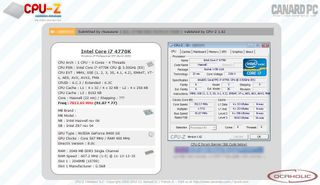Intel's Core i7-4770K Overclocked to 7.0 GHz
It looks like somebody might have overclocked an engineering sample of an i7-4770K to a staggering 7012.65 MHz.

While the Haswell launch is not far away, an overclocker who goes by the nickname "rtiueuiurei" has managed to get his/her hands on an engineering sample of the upcoming Core i7-4770K, and overclock it to an insanely high frequency.
The chip has been overclocked over 7 GHz, to precisely 7012.65 MHz. This was accomplished using a base clock of 91.07 MHz and a multiplier of 77.0. Of course, to keep such a ridiculous overclock stable the CPU needs an insanely high voltage. A staggering 2.56 V was used to accomplish this. Now, it is always possible that CPU-Z read the voltage wrong, because it is quite difficult to imagine that any modern CPU would survive such voltages. That said, we can only assume that "rtiueuiurei" had a very adequate cooling solution to accompany this.
Sadly, we can also question the screenshot, as the CPU-Z ID has been blurred out as well as a number of other things, so there is no way to retrace the post.
Stay on the Cutting Edge
Join the experts who read Tom's Hardware for the inside track on enthusiast PC tech news — and have for over 25 years. We'll send breaking news and in-depth reviews of CPUs, GPUs, AI, maker hardware and more straight to your inbox.
Niels Broekhuijsen is a Contributing Writer for Tom's Hardware US. He reviews cases, water cooling and pc builds.
-
slomo4sho Specialized cooling to maintain a clock speed for a few minutes... Let me know what this chip can do on air or water for an extended period of time.Reply -
Reply10760762 said:Why aren't CPUs already running at a stock speed of 7GHz, anyway?
1st of all, the stock setting is designed to balance performance with average CPU life. Would you buy it a 7GHz stock if many of them died in 1 or 2 years? Secondly, This chip is likely a lucky flaw, and other chips of the same or other production batches range may be fast enough to be called i7-4770k but may have serious problems at this overclocked voltage.
From what I understand of technology, the stock clock speed is generally set to what most of the tested chips can reasonably handle. If the batch gets significantly better because of lessons learned/ higher skill & higher accuracy at the nano-meter level, then we get the slightly up-clocked 'tock' version. the 3500k to your 2500k, etc.
That, and the fact that liquid helium cooling is fairly expensive and labor intensive.
Still, it's amazing the progress that is made, even gradually. It just comes one step at a time. The more expertly made 4770k becomes the 5770k, that affords the equipement to make the 6770k, and in 2 years us enthusiasts like me perhaps have a worthy upgrade :). Some chip that wouldn't be possible without the steps before it. It's hard to design and produce a 7nm chip when you haven't had the experience with 14 and 11nm production.. nor refind the tools and methods and gradually overcome the practical barriers.
etc etc etc.. now i'm just talkin'
neways, I always look forward to upgrading. -
ccovemaker "Sadly, we can also question the screenshot, as the CPU-Z ID has been blurred out as well as a number of other things, so there is no way to retrace the post."Reply
Well if there is one redacted picture of something on the internet it must me true. -
10hellfire01 Reply10761003 said:hmm, hopefully this is a sign that intel used solder instead of lame paste?
Last I remember, there was a rumor or report that they were still using the poor paste. I remember seeing it in an article here...or maybe the main Haswell thread. -
hector2 Reply10760762 said:Why aren't CPUs already running at a stock speed of 7GHz, anyway?
Because of power and the fact that both Intel & AMD realized that performance goes up faster by increasing core count than by increasing frequency. Increasing frequency has diminishing returns in performance while dramatically increasing the power required
Most Popular


